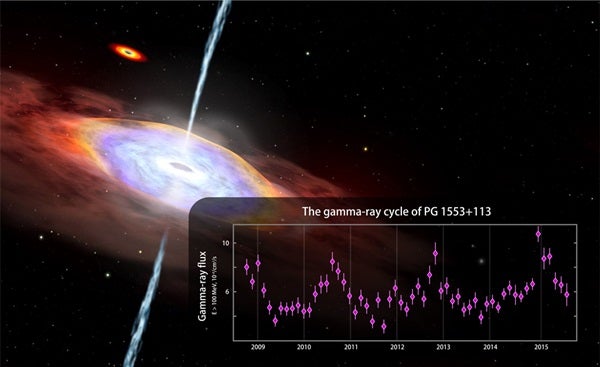“Looking at many years of data from Fermi’s Large Area Telescope (LAT), we picked up indications of a roughly two-year-long variation of gamma rays from a galaxy known as PG 1553+113,” said Stefano Ciprini from the Italian Space Agency’s Science Data Center (ASDC) in Rome. “This signal is subtle and has been seen over less than four cycles, so while this is tantalizing we need more observations.”
Supermassive black holes weighing millions of times the Sun’s mass lie at the hearts of most large galaxies, including our own Milky Way. In about 1 percent of these galaxies, the monster black hole radiates billions of times as much energy as the Sun, emission that can vary unpredictably on timescales ranging from minutes to years. Astronomers refer to these as active galaxies.
More than half of the gamma-ray sources seen by Fermi’s LAT are active galaxies called blazars, like PG 1553+113. As matter falls toward its supermassive black hole, some subatomic particles escape at nearly the speed of light along a pair of jets pointed in opposite directions. What makes a blazar so bright is that one of these particle jets happens to be aimed almost directly toward us.
“In essence, we are looking down the throat of the jet, so how it varies in brightness becomes our primary tool for understanding the structure of the jet and the environment near the black hole,” said Sara Cutini, an astrophysicist at ASDC.
Motivated by the possibility of regular gamma-ray changes, the researchers examined a decade of multiwavelength data. These included long-term optical observations from Tuorla Observatory in Finland, Lick Observatory in California, and the Catalina Sky Survey near Tucson, Arizona, as well as optical and X-ray data from NASA’s Swift spacecraft. The team also studied observations from the Owens Valley Radio Observatory near Bishop, California, which has observed PG 1553+113 every few weeks since 2008 as part of an ongoing blazar monitoring program in support of the Fermi mission.
“The cyclic variations in visible light and radio waves are similar to what we see in high-energy gamma-rays from Fermi,” said Stefan Larsson, a researcher at the Royal Institute of Technology in Stockholm and a long-time collaborator with the ASDC team. “The fact that the pattern is so consistent across such a wide range of wavelengths is an indication that the periodicity is real and not just a fluctuation seen in the gamma-ray data.”
If the gamma-ray cycle of PG 1553+113 is in fact real, they predict it will peak again in 2017 and 2019, well within Fermi’s expected operational lifetime.
The scientists identified several scenarios that could drive periodic emission, including different mechanisms that could produce a years-long wobble in the jet of high-energy particles emanating from the black hole. The most exciting scenario involves the presence of a second supermassive black hole closely orbiting the one producing the jet we observe. The gravitational pull of the neighboring black hole would periodically tilt the inner part of its companion’s accretion disk, where gas falling toward the black hole accumulates and heats up. The result would be a slow oscillation of the jet much like that of a lawn sprinkler, which could produce the cyclic gamma-ray changes we observe.
PG 1553+113 lies in the direction of the constellation Serpens, and its light takes about 5 billion years to reach Earth.










